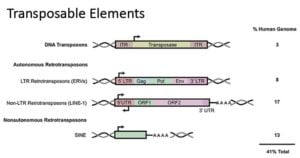

Thus, TEs have played a significant role in genome evolution. There are several ways in which the activity of TEs can positively and negatively impact a genome for example, TE mobilization can promote gene inactivation, modulate gene expression or induce illegitimate recombination. The mobilization of TEs is termed transposition or retrotransposition, depending on the nature of the intermediate used for mobilization. From bacteria to humans, transposable elements have accumulated over time and continue to shape genomes through their mobilization. elegans genome, 37% of the mouse genome, 45% of the human genome, and up to >80% of the genome of some plants like maize. For example, transposable elements comprise approximately 10% of several fish species, 12 % of the C. TEs have been identified in all organisms, prokaryotic and eukaryotic, and can occupy a high proportion of a species’ genome. Transposable elements (TEs) are defined as DNA sequences that are able to move from one location to another in the genome. In this review, we will describe the nature of these elements and discuss recent advances in this field of research, as well as our evolving knowledge of the DNA transposons most widely used in these studies.Įukaryotic genomes contain an abundance of repeated DNA, and some repeated sequences are mobile. Thus, DNA transposons are useful tools to analyze the regulatory genome, study embryonic development, identify genes and pathways implicated in disease or pathogenesis of pathogens, and even contribute to gene therapy.

Indeed, they have been used for transgenesis and insertional mutagenesis in different organisms, since these elements are not generally dependent on host factors to mediate their mobility. As genetic tools, DNA transposons can be used to introduce a piece of foreign DNA into a genome. They are powerful forces of genetic change and have played a significant role in the evolution of many genomes.

DNA transposons move from one genomic location to another by a cut-and-paste mechanism. Repeated DNA makes up a large fraction of a typical mammalian genome, and some repetitive elements are able to move within the genome (transposons and retrotransposons).


 0 kommentar(er)
0 kommentar(er)
